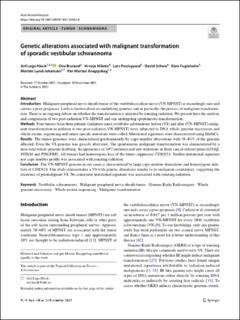| dc.contributor.author | Håvik, Aril Løge | |
| dc.contributor.author | Bruland, Ove | |
| dc.contributor.author | Miletic, Hrvoje | |
| dc.contributor.author | Poulsgaard, Lars | |
| dc.contributor.author | Scheie, David | |
| dc.contributor.author | Fugleholm, Kåre | |
| dc.contributor.author | Lund-Johansen, Morten | |
| dc.contributor.author | Knappskog, Per Morten | |
| dc.date.accessioned | 2022-01-27T09:36:13Z | |
| dc.date.available | 2022-01-27T09:36:13Z | |
| dc.date.created | 2021-12-10T18:19:26Z | |
| dc.date.issued | 2022 | |
| dc.identifier.issn | 0001-6268 | |
| dc.identifier.uri | https://hdl.handle.net/11250/2880691 | |
| dc.description.abstract | Introduction: Malignant peripheral nerve sheath tumor of the vestibulocochlear nerve (VN-MPNST) is exceedingly rare and carries a poor prognosis. Little is known about its underlying genetics and in particular the process of malignant transformation. There is an ongoing debate on whether the transformation is initiated by ionizing radiation. We present here the analysis and comparison of two post-radiation VN-MPNST and one undergoing spontaneous transformation.
Methods: Four tumors from three patients (radiation-naïve vestibular schwannoma before (VS) and after (VN-MPNST) malignant transformation in addition to two post-radiation VN-MPNST) were subjected to DNA whole-genome microarray and whole-exome sequencing and tumor-specific mutations were called. Mutational signatures were characterized using MuSiCa.
Results: The tumor genomes were characterized predominantly by copy-number aberrations with 36–81% of the genome affected. Even the VS genome was grossly aberrated. The spontaneous malignant transformation was characterized by a near-total whole-genome doubling, disappearance of NF2 mutation and new mutations in three cancer-related genes (GNAQ, FOXO4 and PDGFRB). All tumors had homozygous loss of the tumor suppressor CDKN2A. Neither mutational signature nor copy number profile was associated with ionizing radiation.
Conclusion: The VN-MPNST genome in our cases is characterized by large copy-number aberrations and homozygous deletion of CDKN2A. Our study demonstrates a VS with genetic alterations similar to its malignant counterpart, suggesting the existence of premalignant VS. No consistent mutational signature was associated with ionizing radiation. | en_US |
| dc.language.iso | eng | en_US |
| dc.publisher | Springer | en_US |
| dc.rights | Navngivelse 4.0 Internasjonal | * |
| dc.rights.uri | http://creativecommons.org/licenses/by/4.0/deed.no | * |
| dc.title | Genetic alterations associated with malignant transformation of sporadic vestibular schwannoma | en_US |
| dc.type | Journal article | en_US |
| dc.type | Peer reviewed | en_US |
| dc.description.version | publishedVersion | en_US |
| dc.rights.holder | Copyright The Author(s) 2021 | en_US |
| cristin.ispublished | true | |
| cristin.fulltext | original | |
| cristin.qualitycode | 1 | |
| dc.identifier.doi | 10.1007/s00701-021-05062-0 | |
| dc.identifier.cristin | 1967271 | |
| dc.source.journal | Acta Neurochirurgica | en_US |
| dc.source.pagenumber | 343–352 | |
| dc.identifier.citation | Acta Neurochirurgica, 2022, 164, 343–352. | en_US |
| dc.source.volume | 164 | |

